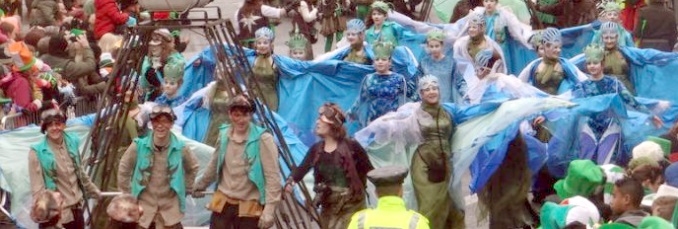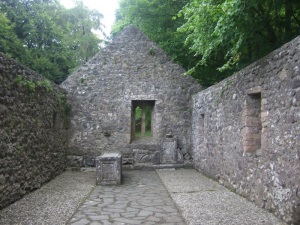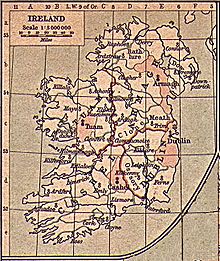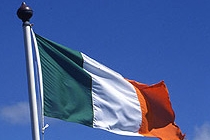Saint Patrick: His Day, His Party and His Myth

Lá Fhéile Pádraig Sona Daoibh (Happy St Patrick's Day)!
To celebrate St Patrick's Day we are re-publishing this popular article.
There is no doubting the immensity of Patrick's presence in the English Speaking world. Without question it is rooted in Irish emigration, but what explains this phenomenon? How is it that a Roman Briton came to be an icon of the modern Celtic world?
As we approach the feast Day of the Patron Saint of Ireland, it is time for the annual nod to the revelers who participate in St Patrick's Day celebrations and to the mythic Saint Patrick himself. One would like to imagine the throngs clogging the streets of most major cities of the “Anglo Saxon” world are soldiers of Celtic identity, but we know most are there because it is a party. Participants in St. Patrick’s Day festivities are measured in the tens of millions. Based on published attendance records for Manchester, Dublin, New York City, Philadelphia, Toronto and Sydney, approaching 5 million people will either participate in or attend the parades in these cities alone.

So much has been written, fact and fiction, about Patrick that the wealth of material is mind numbing. The broad outlines of Patrick’s life are widely known and accepted. That he was from an upper class family in Britain, which at the time of his birth was a province in the waning days of the Roman Empire. That he was the son of a Roman citizen named Calpurnius and that he was kidnapped by Irish raiders and spent much of his early life as a slave in Ireland. That he escaped and travelled to Europe where he studied under Monastic orders as the western empire crumbled around him and that he then rose to be consecrated Bishop of Ireland.
Patrick is generally accepted to have been almost solely responsible for bringing Christianity to Ireland. On closer scrutiny the histories on the introduction of Christianity to Ireland tell a different story. Parts of Ireland were under the Christian sway a century before Patrick’s arrival. Rooted in the cultural and trade links between portions of Ireland and Roman Britain and Gaul before the collapse of the Roman Empire, the Christian faith had taken hold before Patrick was born.
…evidence leads Thomas F. O’Rahilly (Celtic Scholar 1883/1953) to make the sweeping claims that ‘Irish Christianity owes its origin to Britain’, that ‘already before 431 no small part of the population of the south-east and south of Ireland must have been converted by British missionaries’, that British evangelists continued to arrive in Ireland during the next three decades, and that after 461 British influence had the field to itself.
-John R. Walsh/Thomas Bradely

Then there are the many Christian missionaries at work in Ireland before and concurrent with Patrick’s arrival. These early missionaries have wonderfully magical names such as Saint Ciaran of Saigir, Saint Declan of Ardmore and Saint Ailbe of Emly. Ciaran is alleged to have been the first Saint born in Ireland, Saint Ailbe is said to have baptised St. David, the patron Saint of Wales and Declan founded the monastery of Ardmore in Waterford. In a parallel world there might very well be an annual New York Saint Ailbe of Emly Day Parade, perhaps the Sydney Declan of Ardmore Day parade or the Philadelphia Ciaran of Saigir Day Parade.
The narrative of how Patrick has gained general acceptance in the popular imagination as single handedly converting Ireland to Christianity is linked to his missionary work in the north of Ireland in what is now modern Armagh. At the time of his arrival this area of Ireland was still following the traditional Celtic religion with Druids playing a dominant role. Thus we have the many mythical tales of Patrick’s conflict with the Druidical establishment. Patrick was associated with the founding of the church in Armagh which rose to dominate the Christian Church hierarchy in Ireland. To this day Armagh vies with Dublin as the seat of Catholic power in Ireland and since 1866 Armagh has supplied eight Roman Catholic Cardinals versus the three from Dublin. Because Patrick was connected to the founding of the church in Armagh, the embellishment of his role in the conversion of all of Ireland naturally followed:
Legends portray Patrick as the primary force behind Ireland’s peaceful conversion, but he was one of many early missionaries, unimportant in his own time. A century after his death, the monastery in Armagh, supposedly founded by Patrick, began its campaign to dominate the Irish church. As its power grew, so too did the cult of its founder.
-McCaffery/Eaton – PBS
Another factor in Patrick’s rise to fame was the work of Gerald of Wales, a vicious enemy of the Irish, and his famous medieval “Topography of Ireland”. This work was written by Gerald, also known as Giraldus Cambrensis, in his role of the official court chronicler for the rapacious Anglo Normans of the 12th century who were busily raping Ireland at that time. Gerald was of mixed Welsh and Norman ancestry and attached to the Court of King Henry II. Gerald accompanied Henry’s son, the future King John (of Magna Carta fame) when he visited Ireland in 1185. Based on his visit, Gerald wrote the encyclopedic “Topograhia Hibernica” which catalogues all things Irish and which became the final word on Ireland for centuries. In this work Gerald makes short shrift of Saint Patrick, but it was accepted as definitive and it was this passage which did as much as anything else to enshrine Patrick in the eyes of the world as the man who converted Ireland:
…the coming of Patrick…finding the nation sunk in idolatry and immersed in all kinds of superstition, he (Patrick) was the first who, aided by divine grace, preached the faith of Christ, and planted it among them.
So, as we approach the 17th of March let us all honor Saint Patrick for what he is, a symbol of Celtic identity, an icon of Celtic resistance to Anglo Saxon domination of Celtic Ireland and a very good reason for one hell of a Ceili.
Sources
(1) Medieval Ireland – The Enduring Tradition, by Michael Richter: 1983, St. Martins Press
(2) Giraldus Cambrensis, The Topography of Ireland, Translated by Thomas Forester, Revised and Edited with Additional Notes by Thomas Wright: York University – Toronto: – http://www.yorku.ca/inpar/topography_ireland.pd,
(3) A History of the Irish Church 400-700 AD, 1999, John R. Walsh and Thomas Bradely: http://www.catholicireland.net/a-history-of-the-irish-church-400-700-ad-2/
(4) PBS: In Search Of Ancient Ireland – Religion: Carmell McCaffery and Leo Eaton: http://www.pbs.org/wnet/ancientireland/religion.html
(5) St Patrick & Maughold: Transceltic: http://transceltic.com/irish/st-patrick-maughold
- Irish
- English
- Log in to post comments






